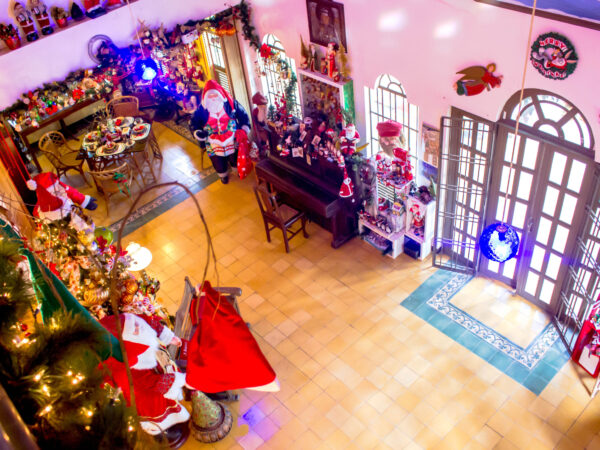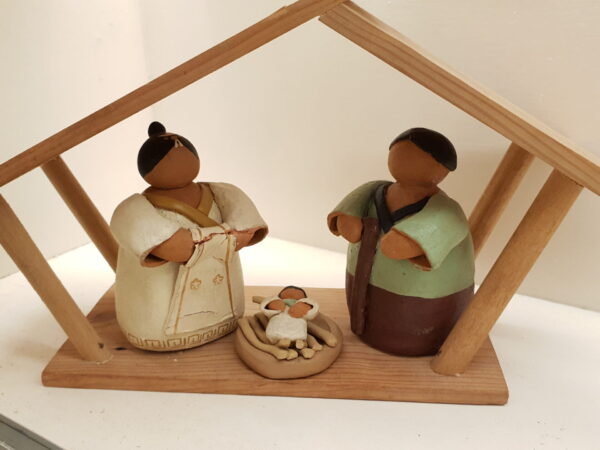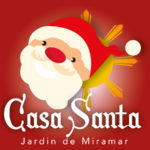about us
about us
Our Mission
We would like to give children the magic of Christmas which they carry to adulthood. Seeing them happy makes you and me happy too.
It’s Everyday Christmas at the Casa Santa Museum in Antipolo!

Know more about the Casa Santa
We have something new in store for you! The Santa’s Toy Factory at the Casa Santa Museum is now open for viewing. Visit the museum during our “open dates” and get “No minimum” viewing during these days.
The Toy Factory is Santa’s workshop. Get to see santa’s elves create the toys for Christmas! Experience this unique display at the new section of the Casa Santa Museum.
The Casa Santa museum is one of the highlights of Jardin de Miramar. It’s a museum of more than 3,700 items with Christmas and Santa Claus themes and motifs from different countries around the world. It’s a wondrous sight to see during the Holidays, and even during the other parts of the year. The Casa Santa has been extensively featured in TV shows like Umagang Kay Ganda,
Unang Hirit, and One Morning, and publications like Star Magazine and Disney Princess. The museum has also been featured on international media, namely Reuters and Associated Press. Lots of attractions and activities are in-store for you!
ARTS AND CRAFTS ACTIVITIES.
These include painting your favorite animation characters in ceramics, Art 101 in canvas and Pinoy games that kids will surely love to play! Lots of attractions and activities are in-store for you! These include painting your favorite animation characters in ceramics, Art 101 in canvas and Pinoy games that kids will surely love to play!
PAPA SANTA
We also have souvenirs such as the huggable “SANTA-ko” rag doll you can purchase at the shop, t-shirts, keychains, refrigerator magnets, For questions about rates and associated packages, please don’t hesitate to call us. Lots of attractions and activities are in-store for you! These include painting your favorite animation characters in ceramics, Art 101 in canvas and Pinoy games that kids will surely love to play!
Casa Santa also offers souvenirs such as the huggable “SANTA-ko” rag doll, t-shirts, keychains, refrigerator magnets, that are all available in the shop and make for appropriate mementos of Casa Santa.
About Us: our museum sections
(interview of collector, Edna N. Del Rosario)
1. Perhaps it’s Filipinos celebrate Christmas at an early period?
- Perhaps it’s a combination of several things. our catholic religion, our wanting to get together with relatives-friends, our smiling/happy disposition.
2. How long does it take to prepare all the decors for the Christmas season?
- Casa Santa is a 365-day exhibit. therefore it’s a continuous preparation for us. but purchasing of Santas happens in the 4th quarter of the year when stores carry Christmas items. For 2014, we have an upgrade of more dramatic lights designed by international light designer, Shoko Matsumoto. Casa Santa has to be dressed up as early as September 1 to prepare for T.V. location shoots. Last 2018, the Casa Santa Museum partnered with Gloria “Dodit” Reyes, a Belen collector based in Quezon City. Her Belen collection used to be housed for several years in Our Lady of Lourdes Church in Tagaytay Highlands and now forms a new section in the Casa Santa Museum. In 2019, the loft of the museum was expanded to contain another new section called Santa’s Toy Factory. The Toy Factory is a creation of Mr. Giacomo Tierra, an Italian craftsman specializing in woodworks and wood carving. This 2020 Mr. Giacomo Tierra completed an addition to the Toy Factory called the Grinch Corner. It lets the viewer experience a different take of the Christmas season’s only hater, to complete the Full Christmas Experience.
- if possible, we’d also like to shoot or accompany you if you are already buying decors for Casa Santa.
- We mostly do our shopping overseas, online.
3. When was the physical structure of Santa’s house completed?
- Original house built in the 1950s; remodeled by Arch. Rosario ‘Ning” Encarnacion-Tan in 1992.
4. Who did it and what were the changes installed in transforming it into Santa’s house?
- When I took over overseeing the property, I did not have the Casa Santa in mind. The Santa collection started in 1994. Arch. Tan at that time did not want the house to look like a city house so she incorporated lattices in the ceilings, pointed eaves, and painted walls of mango fruits/leaf colors. She came out with a postmodern eclectic style which in hindsight was perfect to house the tropical Casa Santa. In 2008 the façade was muralled to simulate Santa’s house by Alfred Galvez, our best muralist in town.<be>
5. Is this a house without any geographical indicators, like in a cold country with snow, or is it a house anywhere in the world where kids believe in Santa?
- In the high ceiling inside the Casa Santa, Muralist Galvez painted a flying Santa on a sleigh with gifts on a superimposed window from the trusses of the ceiling.
6. When did you start collecting the Santas prior to having the house rebuilt? How many countries did you cover?
- I’ve traveled to more than 90 countries and in each of these, I make it a point to buy a representational Santa. I was not successful which included Antarctica. There are other countries, like Myanmar, which is a Buddhist country and do not believe in St. Nicholas/Santa. Therefore, I had to find a representational one. It was their heavenly gods dressed like Santa, with caps and beards.
7. How is your collection evolving?
- When I first started with it in 1994 it was just a few pieces that eventually came to several hundred. If you would compare to a business, you would go first to “tingi” then “sari-sari store” then “entrepreneurial” then “corporate.” I went “entrepreneurial” when I opened the Casa Santa in Christmas 2004 and still working on the “corporate” stage in 2022. We are serious with the collection which has turned into a business now that we have over 3,700 Santas/Christmas items.
8. What was the country from where you got the most Santas?
- 65% of these were bought in the Philippines, especially the big items. The U.S. is a very good source. Germany, particularly Rothenburg, is our third source.
9. What were your criteria in selecting the Santas?
- During the first half, it was just getting all Santas I come across but during the latter half, I became selective, and have been even more selective, purchasing limited edition Christmas themed toys.
- It is Coca Cola’s 6-pc Santa which is just 1.5cm in height.
- There were several trips to the U.S. dedicated to Santa purchases. These were the shopping trips timed after 25 December when the stores drop in prices. The collection is an expensive hobby and therefore I always find ways and means to source the cheapest. However, for items that are a real must, I do not wait for prices to the dropdown.
- Rothenburg, Germany, in the heart of the village is the old fashioned German market place with an all-year-round Christmas Village. The main store there is KatheWohlfahrt’s. They have branches worldwide. Rovaniemi, Santa’s Official Post Office. In 2019, my Christmas dream came true. I visited Rovaniemi, Finland, which is the official post office of Santa, but I was disappointed with their collection. I still think that the Philippines’ Casa Santa can beat their hands down. In 2019 the Santa station closed down. History of Santa Claus. Europe is where the mythical Saint Nicholas (also called Father Christmas, Kris Kringle) started, bringing gifts to homes of good children. It was exported to Canada and the U.S. in the 19th century as caricatures by Thomas Nast; further, it was commercialized by Coca Cola in 1920. It is now depicted from the bishop’s robes of St. Nicholas to a plump, jolly, white-bearded wearing a red coat with white collar called Santa Claus.
- Swarovski, the most expensive one was bought in an airport in Amsterdam. To this day I have been continually buying Swarovski’s annual releases.
- A paper cut out bought in China in the early 1990s.
- P8M.
- The collection is insured.
- Aside from the murals in the ceiling and exterior walls, I brought a fern trunk from Baguio and asked the late artist Aleli Vengua to hand paint it. She used the nodes to paint the 30 different faces of Santas. That’s the most unique and I should say priceless of the collection. Aleli, incidentally, was an exporter of Christmas trimmings to Hallmark/Silvestre/Department 54. She was a great influence on how I started the collection. Also, the Old Man Forest Santa is an unusual, one of a kind piece, which was carved from a trunk in Colorado.
- Tic Tac Toe. Painting by Wilfredo Alicdan’s Naghihintay Kay Santa which we have replicated as Christmas Cards and sold in our Souvenir Shop. Christmas tree trimmings. Stockings. Capturing the exhibit on camera.
- Aside from the specific collection mentioned above, Tin collection (mostly from Germany). Painted eggshell collection (biggest egg from Buenos Aires, Argentina). Oil from the Bone of St. Nicolas from Bari, Italy. Miniature Dog Santa collection. Michael Cacnio’s interpretation using The Bomb (toy collectible) as head and mounting it in a sculptured brass body of Santa. Horse rider handpainted from a small town in Russia.
- There is always a joy when a collector acquires a new piece. Especially now that it has turned into a Museum as each acquisition becomes more defined.
- Their favorite room is Santa’s Playroom. And after that, they hurry to the grounds, run and play at the Galera where the Noah’s Ark is.
- Have you ever lost anything? Am sure there have been some pickpocketing but then we can not avoid that as we do not want the Santas encased in glassed cabinets. Otherwise, it will feel like a traditional museum. But the biggest “heist” was when we hired a decorator to fix the Lego Display and he runs away with 30% of the collection.
- Galera with its rustic playground and Noah’s Ark, mini-Intramuros, the different thematic venues. Plus sculptures and artworks of Eduardo Castrillo, Daniel Dela Cruz, Reggie Yuson, Hannah Liongoren, Michael Cacnio, Tony Leano, Alfred Galvez, Jason Buensalido (who is also an architect who designed the Isla Palma in Jardin’s compound), Moreen Austria, Jordan Mendoza,
- How do you monitor the Santa pieces since there are no roped-off areas in the house? There were very few breakages but we do not any more charges for the visitors.
- It’s a funny toilet inside the Casa Santa and a favorite of visitors.
- The museum is already tight. We can always extend as there is still a big space on the grounds to build on. The property is close to 3 hectares which is only 50% utilized.
- Gives children the magic of Christmas which carries through to adulthood. I would not want to take that away from them. Up till now, when people see the collection during the off-season, they automatically shift to wonderful memories of childhood. Seeing them happy makes me happy too
(interview of collector, Dodit O. Reyes)
1. When was Balay Belen established, soon after the opening of the Casa Santa Museum?
- What also was your motivation to share your collection of Belens/nativity sets?
- I started the Balai Belen exhibit in Jardin de Miramar compound in 2017, after being invited to showcase my collection to complement their Christmas “Santa museum”
- My motivation is mainly to spread the Christmas message and The mystery of the Incarnation to as many as possible. This is my small way of sharing the joy I get from the collection, spread the good news of Christ’s coming, and whenever possible, to use it as an avenue for raising funds for charitable causes (preferably to benefit little children as represented by the infant Jesus).
2. Which Belen is your favorite and why?
- This is a very tough question to answer: each nativity set has a story to tell. I would say that the first one I ever had, which is the Hummel set from Germany, which was handed down to me by my mother, after she passed on in the 1990s but which she purchased during both our travels in 1965, was the very first one I had (Buena mano, so to speak), so it’s very special and I consider it an heirloom of more
than 55 years! - I have a Willow Tree set which a daughter of mine gave to me by installment during several Christmases and birthdays, to complete the set. That, too, is special
- Some items in the collection were given as presents and souvenirs by very dear friends and my children. Each and every piece which has a story behind it, has a very strong sentimental value and special in its own way, as well. Others which I purchased as souvenirs during my travels also bring precious memories of the trip to mind when I see them – whether with my husband, family members, or dear friends.
3. How many Belens are in your collection?
- around 700 more or less? In this collection, I would say more than half are on display, in all sizes, from miniatures to table model size. The one at the entrance is short of life-size.
4. Why did you decide to start collecting nativity sets from around the world?
- It all began with the one I got from my mom. After that,
when I had children, I thought I’d get each one a set for their homes later on….after that, I never stopped as one set was always too nice to ignore, plus friends started thinking of me during their travels and gave me pasalubongs and birthday/Christmas gifts to add to the collection.
5. From which continents and countries did these come from?
- I have from North America (Canada, USA, and Mexico): Central and South America (Peru, Guatemala, Bolivia, among others), Europe (Spain, Portugal, France, Germany, Poland, Eastern Europe, etc..); Africa (Ethiopia, Egypt, Turkey, Cameroon); Asia (China, Japan, Korea, Philippines, Thailand, Indonesia, Singapore); Australia,
6. And did you acquire these yourself or also given as gifts from family and friends?
- All of the above.
7. Please describe the dioramas of different continents on display which continents are these?
- – These cover the continents of Australia, Asia, North America, South America, and Europe. They depict in miniature the different landmarks and sites in the various continents.
8. Who designed these for your collection?
- – I conceptualized what I wanted (a 3-d depiction showing important monuments and landmarks in each continent (e.g. great wall of China, pyramids of Egypt, pagodas, and temples in miniature – sort of like an aerial view of each continent. I explained what I wanted to an artist whom I met by sheer accident and a good chance, Giacomo Cerra, and Italian married to a Bicolana….it was a serendipitous meeting which was surely arranged by God!
9. What other interesting info would you want to share about Balay Belen?
- – I’m very proud of the diorama in the Hall of Continents which showcases many miniatures in the various landmarks globally…it portrays the universality of the Christmas message of love, peace, and goodwill to all!
- As the Holy Family went from inn to inn to find a place, my collection has been exhibited in a number of venues like the UST The museum, Tagaytay Highlands, College of the Holy Spirit, and Lourdes Church in Tagaytay, but all temporary shelters. It is my wish and hopes that my collection has found its permanent home.



